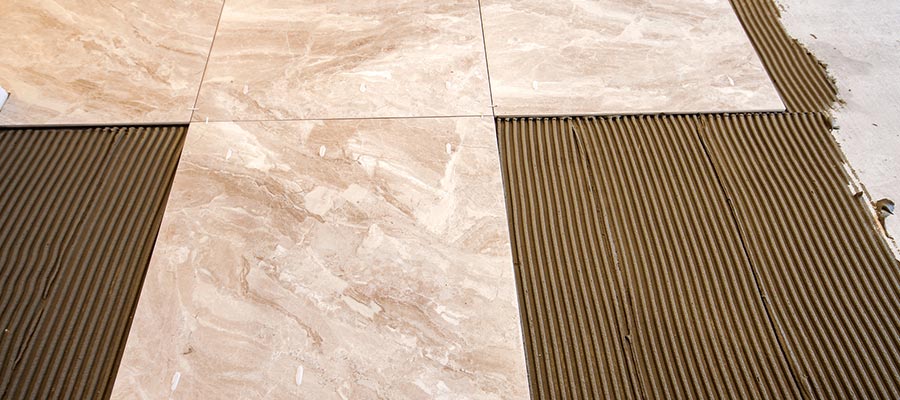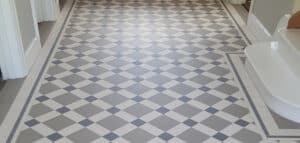Understanding Tiled Surfaces
Tiled surfaces, with their wide range of design options and durability, are a popular choice for many homeowners and contractors. However, understanding how to maintain these surfaces correctly is vital to ensure their longevity.
The Importance of Tiled Surface Maintenance
Proper maintenance of tiled surfaces is essential for several reasons. Firstly, it helps to preserve the aesthetic appeal of the tiles. Regular cleaning prevents the build-up of dirt and grime, keeping the tiles looking as good as new.
Secondly, maintenance ensures the durability of the tiles. Tiles, especially those on floors and in high-traffic areas, are subject to wear and tear. Proper care can prevent damage, prolonging the life of the tiles.
Finally, maintenance contributes to the hygiene of the space. Particularly in areas like the kitchen and bathroom, tiles can harbor bacteria and other germs. Regular cleaning can ensure a safe and healthy environment.
For a comprehensive guide on “how to maintain your tiled surfaces: easy cleaning tips,” check out our article on tiling.
Different Types of Tiled Surfaces
There are various types of tiles available in the market, each with its own unique characteristics and maintenance requirements.
- Ceramic Tiles: Composed of clay and other natural materials, ceramic tiles are durable and easy to clean. They’re available in a wide range of colors and designs.
- Porcelain Tiles: These are a type of ceramic tile that is fired at higher temperatures, making them denser and more resistant to moisture.
- Natural Stone Tiles: These include marble, granite, slate, and limestone. Natural stone tiles are durable and offer a unique, natural look. However, they require special care to prevent damage.
- Glass Tiles: These are often used for backsplashes and accent walls. Glass tiles are resistant to stains and mildew, but they can be prone to scratching.
- Cement Tiles: These tiles are highly durable and come in a variety of patterns. They’re often sealed to protect against stains and water damage.
Understanding the type of tile you have is the first step in effective maintenance. For more information on different tile types and their unique care requirements, refer to our guide on choosing the right tile for your kitchen.
Essential Cleaning Tips
Maintaining the beauty and integrity of your tiled surfaces requires both daily maintenance routines and periodic deep cleaning techniques. The following sections provide easy cleaning tips to help you keep your tiles looking pristine.
Daily Maintenance Routines
Everyday maintenance is the first line of defense in preserving the condition of your tiled surfaces. Regular light cleaning helps to prevent the build-up of dust, dirt, and grime.
- Sweeping: Use a soft-bristle broom to sweep the floor daily. This helps to remove loose dirt and debris that can scratch the surface of the tiles.
- Wiping: For wall tiles, a quick daily wipe with a damp cloth can help to keep them clean and shiny.
- Mopping: Mop your floor tiles at least once a week using warm water. If necessary, a mild detergent can be added to the water.
- Drying: Always dry your tiles after cleaning to prevent water spots and streaks. A microfiber cloth or dry mop can be used for this purpose.
It’s important to note that certain types of tiles may require specific cleaning methods. Always refer to the manufacturer’s instructions or consult with a tiling professional for the best results.
Deep Cleaning Techniques
While daily cleaning goes a long way in maintaining your tiles, a deeper clean is necessary from time to time to tackle stubborn dirt and stains.
- Grout Cleaning: Grout can become discolored over time. Use a suitable grout cleaner and a small brush to scrub the grout lines. Always rinse the area thoroughly after cleaning. Check out our guide on grouting techniques for perfect finishes every time for more insights.
- Stain Removal: For tough stains on your tiles, a mixture of baking soda and water can be used. Apply the paste to the stain, leave it for a few minutes, then scrub gently with a soft brush.
- High-Traffic Areas: Areas that receive a lot of foot traffic may require extra attention. Consider using a steam cleaner for these areas, as the steam can help to loosen dirt and grime.
Remember, different types of tiles may require different cleaning methods. Always ensure to use cleaning products and techniques that are suitable for your specific type of tile.
By incorporating these daily maintenance routines and deep cleaning techniques into your cleaning schedule, you can help prolong the life of your tiles and keep them looking their best. Don’t miss out on our other articles that provide more tips and insights on tiling.
Tackling Common Tile Problems
When maintaining tiled surfaces, it’s common to encounter issues such as stains on tiles and grout discoloration. Let’s explore how to tackle these problems effectively.
Dealing with Stains on Tiles
Stains on tiles can be a result of spills, dirt, or everyday wear and tear. These can affect the appearance of your tiles, but with the right approach, they can be effectively removed.
For general stains, a solution of warm water and mild dish soap can be used. Apply the solution to the stain and gently scrub using a soft brush or cloth. Rinse with warm water and dry the area thoroughly.
For tougher stains, a baking soda and water paste can be applied to the stain. Let it sit for a few minutes and then scrub gently with a soft brush. Rinse with warm water and dry the area.
In case of stubborn stains, it may be necessary to use a professional tile cleaner. Always remember to follow the manufacturer’s instructions when using these products and test on a small area first to ensure it does not discolor or damage the tile.
Handling Grout Discoloration
Grout discoloration is often due to dirt, grime, or mildew. Cleaning grout can be a bit more challenging due to its porous nature.
For mild grout discoloration, a solution of equal parts vinegar and warm water can be used. Apply this solution using a toothbrush and scrub gently. Rinish with warm water and dry thoroughly.
For moderate grout stains, a paste of baking soda and water can be used. Apply the paste to the grout and let it sit for a few minutes before scrubbing with a toothbrush. Rinse and dry the area thoroughly.
If the grout discoloration is severe, a professional grout cleaner may be required. As with tile cleaners, always follow the manufacturer’s instructions and test on a small area first.
Remember, regular maintenance can help prevent stains on tiles and grout discoloration. Consider sealing your grout to protect it from stains and discoloration. For more tips on maintaining your tiled surfaces, check out our guide on how to maintain your tiled surfaces: easy cleaning tips.
Tips for Different Tiled Surfaces
An integral part of maintaining the aesthetic appeal and longevity of your tiled surfaces is understanding how to clean them properly. Different types of tiles require different cleaning methods due to their unique properties. In this section, we will discuss cleaning tips for three common types of tiles: ceramic, porcelain, and natural stone tiles.
Tips for Cleaning Ceramic Tiles
Ceramic tiles are popular due to their durability and easy maintenance. For regular cleaning, it is recommended to sweep or vacuum ceramic tiles to remove loose dust and debris. A damp mop or cloth with a mild detergent can then be used for a more thorough clean.
For stubborn stains on ceramic tiles, a non-abrasive cleaning solution should be used. Always remember to rinse off the cleaning solution with water to prevent any residue build-up, and dry the tiles to avoid water spots and streaks.
For more detailed information about ceramic tiles and their maintenance, refer to our article on choosing the right tile for your kitchen: a guide.
Tips for Cleaning Porcelain Tiles
Porcelain tiles are known for their resistance to stains and moisture, making them an excellent choice for areas such as bathrooms and kitchens. Regular cleaning of porcelain tiles can be done with a soft brush or vacuum to remove dust and debris, followed by a damp mop with a mild detergent for a deeper clean.
For stubborn stains on porcelain tiles, use a cleaning solution that is specifically designed for porcelain surfaces. Always remember to rinse the tiles thoroughly after cleaning to prevent residue build-up.
To learn more about how to maintain porcelain tiles, visit our article on maximize your space: expert tips for tiling small bathrooms.
Tips for Cleaning Natural Stone Tiles
Natural stone tiles such as granite, marble, and slate require a different approach to cleaning due to their porous nature. Avoid using acidic or abrasive cleaners as these can damage the surface of the stone.
For daily cleaning, dust and sweep the tiles to remove loose debris. Use a stone-safe cleaner diluted with warm water for a deeper clean. It’s also recommended to periodically seal natural stone tiles to protect them from stains and damage.
For more information on caring for natural stone tiles, check out our article on the top 5 trends in tiling for 2023.
No matter the type of tile you own, remember that regular cleaning and proper maintenance are essential in preserving the beauty and longevity of your tiled surfaces. With these tips in mind, you can keep your tiled surfaces looking their best for years to come.
Protecting Your Tiled Surfaces
Once you’ve mastered the art of cleaning your tiles, the next step is to ensure you’re protecting them for longevity. This includes understanding how and when to apply sealants, setting preventive measures, and recognizing when to bring in professionals for assistance.
Sealant Application: Why and When
Applying a sealant to your tiled surfaces is an excellent preventive measure that can protect your tiles from various types of damage. Sealants create a barrier on the tile surface that repels water, oils, and other substances, preventing stains and keeping your tiles looking new for longer.
The need for sealant application varies depending on the type of tile. For instance, glazed ceramic and porcelain tiles are already protected and typically do not require sealing. However, unglazed tiles such as natural stone, terra-cotta, and some porcelain tiles may require sealing to protect them from stains and water penetration.
Sealant application should generally be done after a new tile installation and repeated every one to two years thereafter. However, high traffic areas or areas exposed to excessive moisture may require more frequent applications. For a detailed guide on tile adhesives and sealants, check our article on understanding tile adhesives: a complete guide.
Preventive Measures for Long-lasting Tiles
Beyond sealant application, there are several other preventive measures you can take to prolong the life of your tiles:
- Regular Cleaning: As discussed in the section on essential cleaning tips, maintaining a regular cleaning routine helps to prevent dirt and grime build-up, which can cause damage over time.
- Promptly Address Stains: Whenever a spill occurs, it’s important to clean it up immediately to prevent staining or damage to the tile surface.
- Use Protective Pads: Consider using protective pads under heavy furniture to prevent scratches or cracks on your tiled floors.
- Avoid Harsh Chemicals: Some cleaning agents can be too harsh for certain types of tiles and can cause discoloration or damage. Always ensure that your cleaning products are suitable for your specific tile type.
Recognizing When Professional Help is Needed
While regular maintenance and preventive measures can significantly prolong the life of your tiles, there may be times when professional help is required. This could be due to severe staining, chips or cracks in the tiles, or stubborn grout discoloration that cannot be removed with household cleaning methods.
If you’re unsure about whether professional help is needed, it’s always better to consult with a professional tiler or tiling service. They can provide expert advice and take the necessary steps to restore your tiles to their original state. For more advanced tiling tips and techniques, check our article on advanced tiling tips for commercial projects.
Protecting your tiled surfaces is an essential part of tile maintenance. By applying sealants when necessary, implementing preventive measures, and recognizing when to seek professional help, you can ensure that your tiles remain in excellent condition for many years to come.




